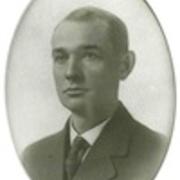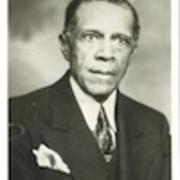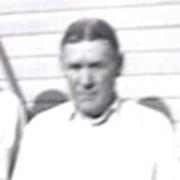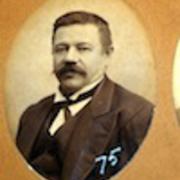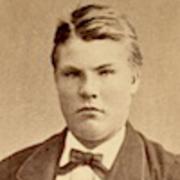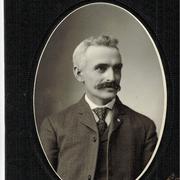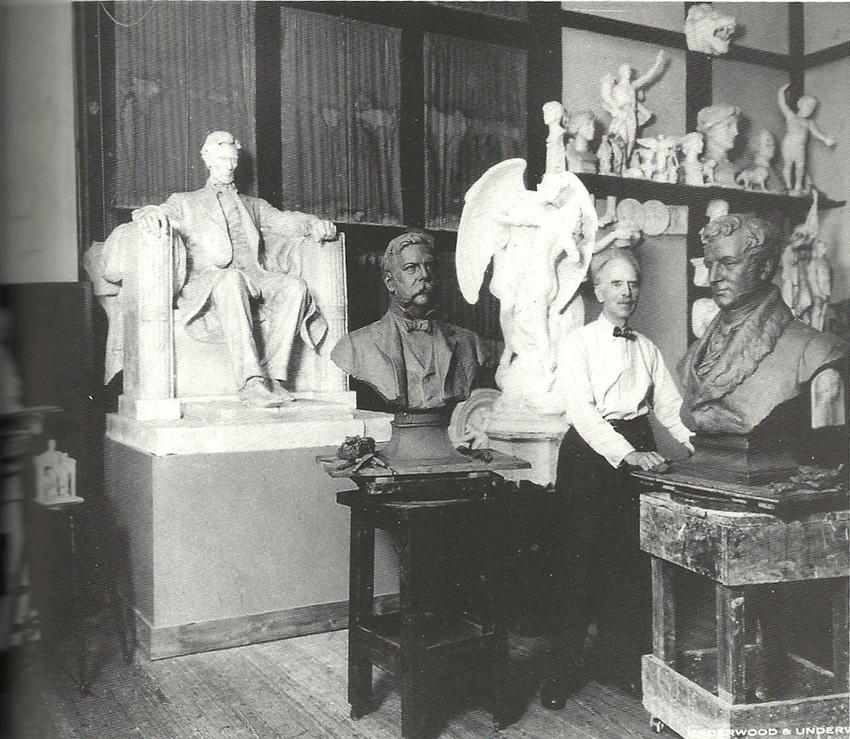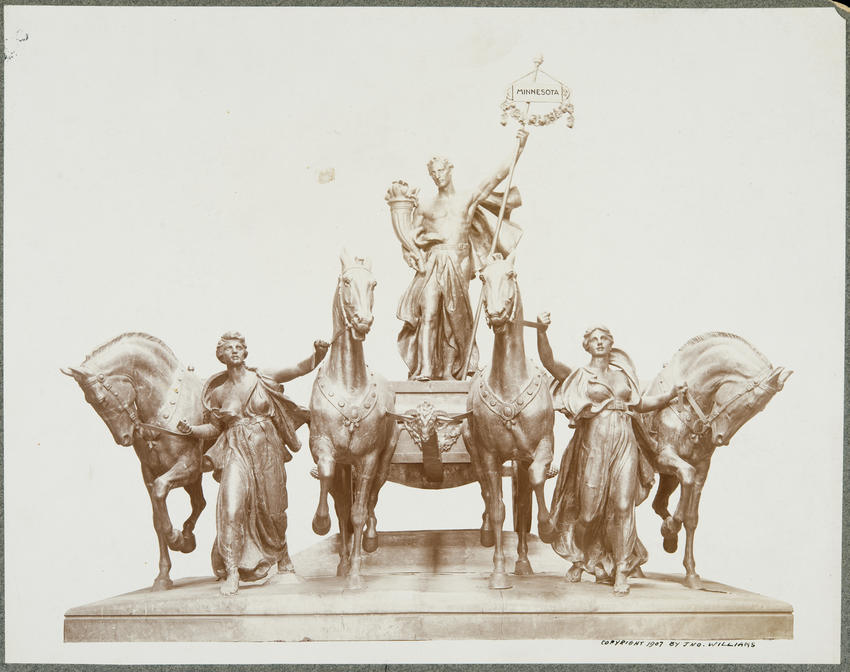
Daniel Chester French
Daniel Chester French (1850-1931) was one of the most American prominent scuptors of his time. He was commissioned to create the models for the six virtues sculptures above the entrance of the Minnesota State Capitol, as well as the bronze, gold leaf-covered Qudrega sculpture (with E.C. Potter). A plaster model of one of the figures incoporated into the Quadriga can be seen in the photo of French in his studio.
Article from the New York Metropolitan Museum of Art website by Thayer Tolles
Between 1870 and 1874, French executed twenty-five decorative statuettes in plaster; some, such as Joe’s Farewell (57.147), were reproduced in parian. French’s first foray into public art came in 1873, when his hometown of Concord, through the auspices of family friend Ralph Waldo Emerson, commissioned The Minute Man (1871–75; Minuteman National Historic Park) to commemorate the centennial of the Battle of Concord. Although the full-size bronze responds compositionally to the Apollo Belvedere, it contained the seeds of the Beaux-Arts aesthetic with which French would become synonymous along with his genial competitor Augustus Saint-Gaudens
.
Departing for Florence in October 1874, French was one of the last significant American sculptors to opt for training in Italy over Paris. Although he later regretted not gaining earlier exposure to Parisian modeling techniques, his two years abroad were productive ones; he lived with the family of sculptor Preston Powers and worked in the studio of Thomas Ball. The Awakening of Endymion (1875–79; Chesterwood, Stockbridge, Mass.), a reflection of his time in Italy, is in the Neoclassical style, a mode he abandoned on returning to the United States in August 1876.
In the succeeding years, French operated studios in Concord, Boston, and Washington, D.C., undertaking portraits and public work. He earned commissions for marble allegorical groups for new government buildings in Saint Louis (1876–82), Philadelphia (1878–82), and Boston (1880–85). He also modeled portraits in a naturalistic, fluid style. Notable for their evocation of the physical and psychological are his bust of poet and philosopher Ralph Waldo Emerson (07.101) and his seated bronze statue of John Harvard (1883–84; Harvard University), founder of the college. French departed in October 1886 for Paris, where he stayed until July 1887, finally having an extended opportunity to study Beaux-Arts sculpture.
Upon his return to the United States, French’s next major commission was a memorial in honor of Dr. Thomas Gallaudet, founder of the first free school for the deaf in America (1885–89; Gallaudet College, Washington, D.C.). The seated doctor and standing figure of a young pupil, Alice Cogswell, are boldly modeled, exhibiting French’s confident handling of the bronze medium. His first ideal monument, the Milmore Memorial (1889–93; Forest Hills Cemetery, Jamaica Plain, Mass.; 26.120, is a tribute to the sculptors Martin and Joseph Milmore. In linking naturalistic treatment of human form with ideal subject matter, French set new standards for funereal sculpture. He also popularized the use of a draped female figure for symbolic effect, a leitmotif in much of his later work.
French was innovative in memorial sculpture, often combining portrait and allegorical conceptions into architectural settings, as in the John Boyle O’Reilly Memorial (1892–96; the Fenway, Boston) and Richard Morris Hunt Memorial (1896–1901; Fifth Avenue at 70th Street, New York; (2013.135.1,2013.135.2). The Melvin Memorial (1906–8, Concord, Mass.;15.75) is considered by many to be French’s finest ideal sculpture. A tribute to three brothers killed during the Civil War , it is composed of a female figure emerging from a block of stone—an ethereal consideration of mortality. In contrast, the Spencer Trask Memorial (1913–15; Congress Park, Saratoga, N.Y.), also known as The Spirit of Life, celebrates the energy and drama of life as expressed by a draped female form with raised arms. French’s reputation in memorial work was extended through the production of replicas and reductions, in marble by the Piccirilli Brothers and in bronze through several New York foundries, including Henry-Bonnard, Roman Bronze Works, and John Williams.
Some of French’s most illustrious monumental sculpture was executed in conjunction with American architects at the forefront of the City Beautiful Movement. For the entrance to McKim, Mead, and White’s Boston Public Library, French completed three sets of bronze doors (1894–1904), adeptly modeling single female figures in low relief to ornament each valve. French’s imposing seated figure Alma Mater (1900–1903) is installed on the steps of McKim’s Low Library at Columbia University. The collaborative effort between Cass Gilbert and prominent sculptors for the United States Custom House (1903–7; New York) resulted in French’s four Continents (Asia, America, Europe, and Africa) for the entrance blocks of that building. His most steadfast architect colleague was Henry Bacon; their years of fruitful creativity on nearly fifty projects reached an apogee in the Lincoln Memorial in Washington, D.C., for which French completed the massive seated Lincoln (1911–22), his best known sculpture. The sculpture is composed of twenty blocks of Georgia marble, carved in the Bronx studio of the Piccirilli Brothers, and assembled on site in Washington.
Over his career of six decades, French gave generously of his time to various artistic organizations, including the American Academy in Rome, the Art Students League, the National Arts Commission, and the National Sculpture Society. French was a trustee of The Metropolitan Museum of Art from 1903 until his death in 1931, serving as the chairman of the committee on sculpture. During those years, he was responsible for the accession of the Museum’s core collection of American sculpture. French led an ordered life divided between New York, where he settled in 1888, and his summer home and studio, Chesterwood, in Glendale, near Stockbridge, Massachusetts, where he bought property in 1897. Chesterwood was given by his daughter, Margaret French Cresson, to the National Trust for Historic Preservation in 1969. It is open to the public on a seasonal basis.
Thayer Tolles
The American Wing, The Metropolitan Museum of Art
June 2010
